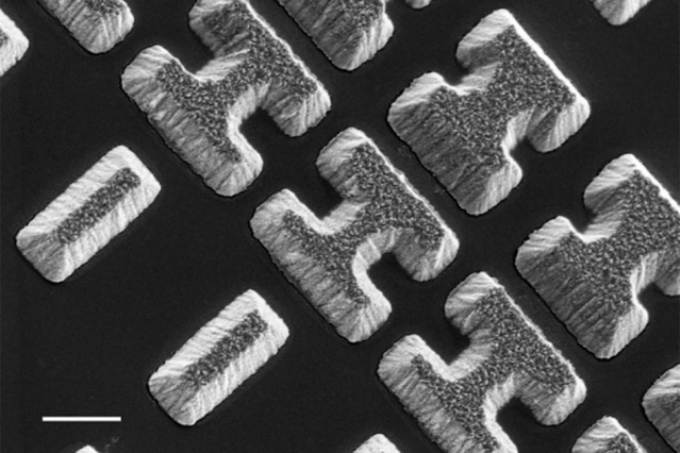May 2 2018
Scientists at MIT and other institutions have developed an innovative technique for capturing images in the mid-infrared (mid-IR) range of the spectrum, which could be used in a broad range of applications, such as free-space communication, biomedical sensing, and thermal imaging.
 Scanning Electron Microscope image shows a few of the carefully designed shapes of the chalcogenide glass deposited on a clear substrate. The shapes, which the researchers call “meta-atoms,” determine how mid-infrared light is bent when passing through the material. (Image credit: the researchers)
Scanning Electron Microscope image shows a few of the carefully designed shapes of the chalcogenide glass deposited on a clear substrate. The shapes, which the researchers call “meta-atoms,” determine how mid-infrared light is bent when passing through the material. (Image credit: the researchers)
The mid-infrared range of electromagnetic radiation is a specifically beneficial range of the spectrum in that it can enable sensitive detection of many chemical and biomolecular signals, trace heat signatures, and allow imaging in the dark. However, it has been difficult to design optical systems for this range of frequencies. Moreover, devices using them are expensive and highly specialized. At present, the scientists have stated that they have developed a mass-manufacturable and highly efficient strategy for detecting and controlling these waves.
The results of the study have been published in the Nature Communications journal, in a paper by MIT scientists Tian Gu and Juejun Hu, the University of Massachusetts at Lowell scientist Hualiang Zhang, and 13 others from MIT, the University of Electronic Science and Technology of China, and the East China Normal University.
The new strategy involves the use of a flat, artificial material formed of nanostructured optical elements, in the place of the common thick, curved-glass lenses used in traditional optics. These elements are developed by employing methods analogous to those used for computer chips and offer on-demand electromagnetic responses.
“This kind of metasurface can be made using standard microfabrication techniques,” stated Gu. “The manufacturing is scalable.”
He further stated that “there have been remarkable demonstrations of metasurface optics in visible light and near-infrared, but in the mid-infrared, it’s moving slowly.”
He added that when the study was started, the following question arose because they could develop these devices extremely thin: “Could we also make them efficient and low-cost?” The researchers state that they have now accomplished exactly this.
In the new device, an array of accurately shaped thin-film optical elements known as “meta-atoms” formed of chalcogenide alloy is used. The array has a high refractive index, which helps in developing ultrathin, high-performance structures known as meta-atoms. The shapes of these meta-atoms resemble block letters like H or I and are deposited and patterned on an IR-transparent fluoride substrate. The thicknesses of the tiny shapes are a fraction of the wavelengths of the light under observation. Together these shapes function like a lens. They enable almost arbitrary wavefront manipulation, which cannot be achieved by using natural materials at larger scales; however, they have only a tiny fraction of the thickness, and hence require only less amount of material.
“It’s fundamentally different from conventional optics,” stated Gu.
The process “allows us to use very simple fabrication techniques,” explained Gu, through thermal evaporation of the material onto the substrate. The researchers have applied the method to 6-inch wafers with high throughput, a standard in microfabrication, and “we’re looking at even larger-scale manufacturing.”
According to Gu, almost 80% of the mid-IR light is transmitted by the devices, with optical efficiencies of nearly 75 percent, indicating considerable enhancement over prevalent mid-IR metaoptics. They can also be made very thin and light compared to traditional IR optics. The researchers can employ the same technique, by varying the pattern of the array, to arbitrarily develop distinctive types of optical devices, including complex aspheric lenses, a cylindrical or spherical lens, and a simple beam deflector. It has been shown that the lenses have the ability to focus mid-IR light with the maximum theoretically possible sharpness, or the diffraction limit.
These methods enable the development of metaoptical devices with the ability to manipulate light in more intricate ways than that is accomplished with the help of traditional bulk transparent materials, stated Gu. The devices also have the potential to regulate polarization and other characteristics.
Mid-IR light plays a vital role in various fields. According to the researchers, it includes the characteristic spectral bands of most kinds of molecules and effectively penetrates into the atmosphere. Therefore, it is very important in detecting a broad array of substances, for instance, in environmental monitoring, and also for industrial and military applications. Due to the fact that majority of the normal optical materials used in the near-infrared or visible ranges are completely opaque to these wavelengths, it has been very challenging and expensive to develop mid-IR sensors. Hence, the new technique could pave the way for completely innovative, potential applications, such as in imaging products or consumer sensing, stated Gu.
The study was funded by the Defense Advanced Research Projects Agency (DARPA), under the Extreme Optics and Imaging Program, and the National Natural Science Foundation of China.